实义动词
- 格式:docx
- 大小:17.26 KB
- 文档页数:6
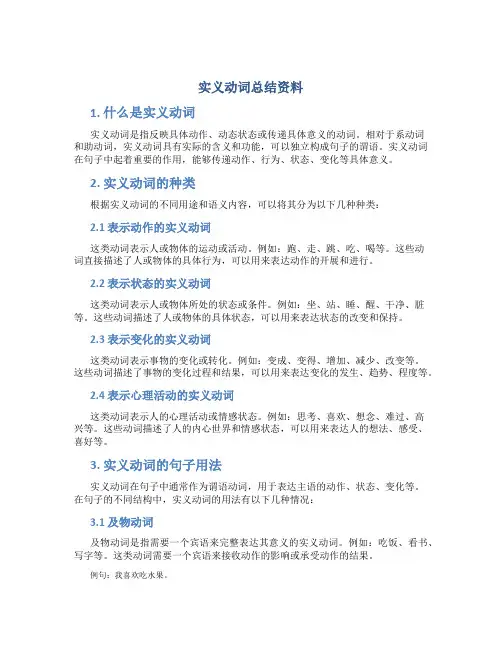
实义动词总结资料1. 什么是实义动词实义动词是指反映具体动作、动态状态或传递具体意义的动词。
相对于系动词和助动词,实义动词具有实际的含义和功能,可以独立构成句子的谓语。
实义动词在句子中起着重要的作用,能够传递动作、行为、状态、变化等具体意义。
2. 实义动词的种类根据实义动词的不同用途和语义内容,可以将其分为以下几种种类:2.1 表示动作的实义动词这类动词表示人或物体的运动或活动。
例如:跑、走、跳、吃、喝等。
这些动词直接描述了人或物体的具体行为,可以用来表达动作的开展和进行。
2.2 表示状态的实义动词这类动词表示人或物体所处的状态或条件。
例如:坐、站、睡、醒、干净、脏等。
这些动词描述了人或物体的具体状态,可以用来表达状态的改变和保持。
2.3 表示变化的实义动词这类动词表示事物的变化或转化。
例如:变成、变得、增加、减少、改变等。
这些动词描述了事物的变化过程和结果,可以用来表达变化的发生、趋势、程度等。
2.4 表示心理活动的实义动词这类动词表示人的心理活动或情感状态。
例如:思考、喜欢、想念、难过、高兴等。
这些动词描述了人的内心世界和情感状态,可以用来表达人的想法、感受、喜好等。
3. 实义动词的句子用法实义动词在句子中通常作为谓语动词,用于表达主语的动作、状态、变化等。
在句子的不同结构中,实义动词的用法有以下几种情况:3.1 及物动词及物动词是指需要一个宾语来完整表达其意义的实义动词。
例如:吃饭、看书、写字等。
这类动词需要一个宾语来接收动作的影响或承受动作的结果。
例句:我喜欢吃水果。
3.2 不及物动词不及物动词是指不需要宾语即可独立使用的实义动词。
例如:跑、睡、笑等。
这类动词表达主语的动作或状态,不需要宾语来完整表达意义。
例句:他跑得很快。
3.3 联系动词联系动词是指与主语之间建立联系,并将主语与补足语联系起来的实义动词。
例如:是、变成、变得等。
这类动词用于传递主语的状态、性质或特征,与主语一起构成句子的谓语。
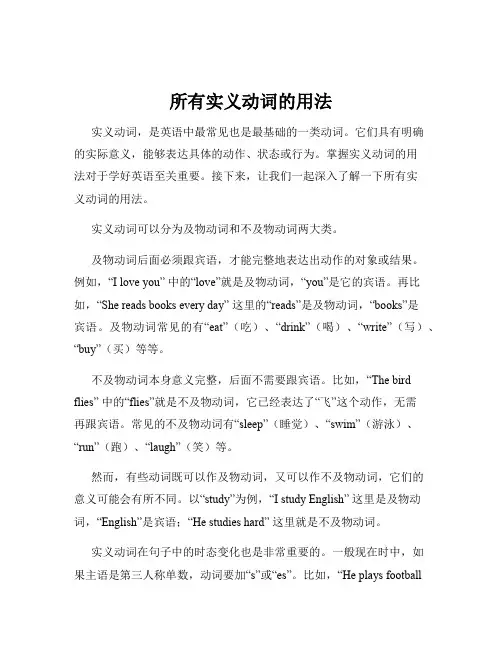
所有实义动词的用法实义动词,是英语中最常见也是最基础的一类动词。
它们具有明确的实际意义,能够表达具体的动作、状态或行为。
掌握实义动词的用法对于学好英语至关重要。
接下来,让我们一起深入了解一下所有实义动词的用法。
实义动词可以分为及物动词和不及物动词两大类。
及物动词后面必须跟宾语,才能完整地表达出动作的对象或结果。
例如,“I love you” 中的“love”就是及物动词,“you”是它的宾语。
再比如,“She reads books every day” 这里的“reads”是及物动词,“books”是宾语。
及物动词常见的有“eat”(吃)、“drink”(喝)、“write”(写)、“buy”(买)等等。
不及物动词本身意义完整,后面不需要跟宾语。
比如,“The bird flies” 中的“flies”就是不及物动词,它已经表达了“飞”这个动作,无需再跟宾语。
常见的不及物动词有“sleep”(睡觉)、“swim”(游泳)、“run”(跑)、“laugh”(笑)等。
然而,有些动词既可以作及物动词,又可以作不及物动词,它们的意义可能会有所不同。
以“study”为例,“I study English” 这里是及物动词,“English”是宾语;“He studies hard” 这里就是不及物动词。
实义动词在句子中的时态变化也是非常重要的。
一般现在时中,如果主语是第三人称单数,动词要加“s”或“es”。
比如,“He plays footballevery weekend” 一般过去时则要将动词变成过去式,如“I ate an apple yesterday” 现在进行时要用“be +动词的现在分词”形式,“They are reading books n ow” 过去进行时是“was/were +动词的现在分词”,“I was watching TV at eight o'clock last night” 将来时可以用“will +动词原形”或者“be going to +动词原形”,“I will go to Beijing next week” 或者“She is going to have a party tomorrow”实义动词还有主动语态和被动语态之分。
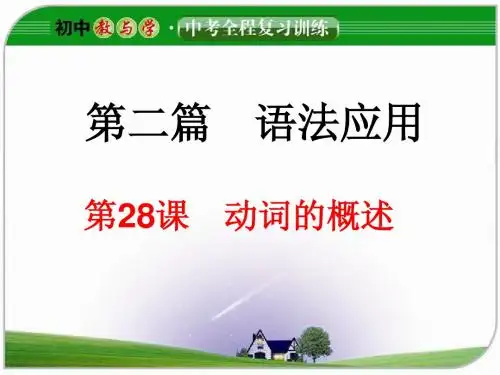
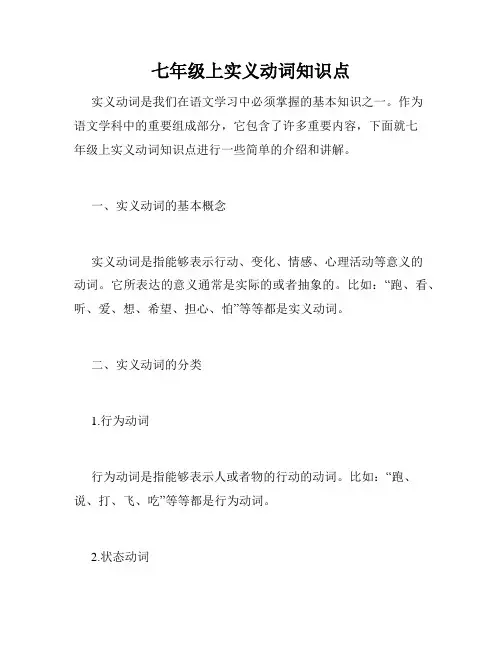
七年级上实义动词知识点实义动词是我们在语文学习中必须掌握的基本知识之一。
作为语文学科中的重要组成部分,它包含了许多重要内容,下面就七年级上实义动词知识点进行一些简单的介绍和讲解。
一、实义动词的基本概念实义动词是指能够表示行动、变化、情感、心理活动等意义的动词。
它所表达的意义通常是实际的或者抽象的。
比如:“跑、看、听、爱、想、希望、担心、怕”等等都是实义动词。
二、实义动词的分类1.行为动词行为动词是指能够表示人或者物的行动的动词。
比如:“跑、说、打、飞、吃”等等都是行为动词。
2.状态动词状态动词是指能够表示人或者物的状态的动词。
比如:“是、在、有、属于、喜欢”等等都是状态动词。
3.感官动词感官动词是指能够表示人的五种感觉的动词。
比如:“看、听、闻、尝、摸”等等都是感官动词。
4.心理动词心理动词是指能够表示人的内心活动的动词。
比如:“喜欢、讨厌、感觉、爱、恨、想”等等都是心理动词。
5.自然现象动词自然现象动词是指能够表示自然现象的动词。
比如:“下雨、飘雪、地震、火山喷发、闪电”等等都是自然现象动词。
三、实义动词的时态变化实义动词的时态变化分为“一般现在时、一般过去时、一般将来时、现在进行时、过去进行时、将来进行时”等六个方面。
例如:一般现在时:我喜欢吃西瓜。
We love playing basketball.一般过去时:我昨天吃了一大块蛋糕。
He saw a beautiful bird yesterday.一般将来时:明天我们要去爬山。
They will have a trip next month.现在进行时:你在写作业吗?She is reading a book at the moment.过去进行时:我昨天这个时候正在睡觉。
They were watching TV all night.将来进行时:明年你们毕业时,我还在为中考做准备。
They will be visiting China this time next year.四、实义动词的语态变化实义动词的语态变化分为“主动语态、被动语态”两个方面。
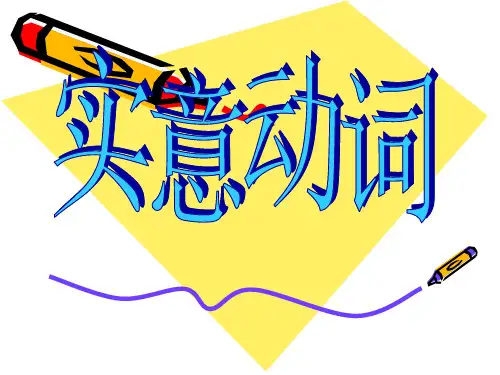
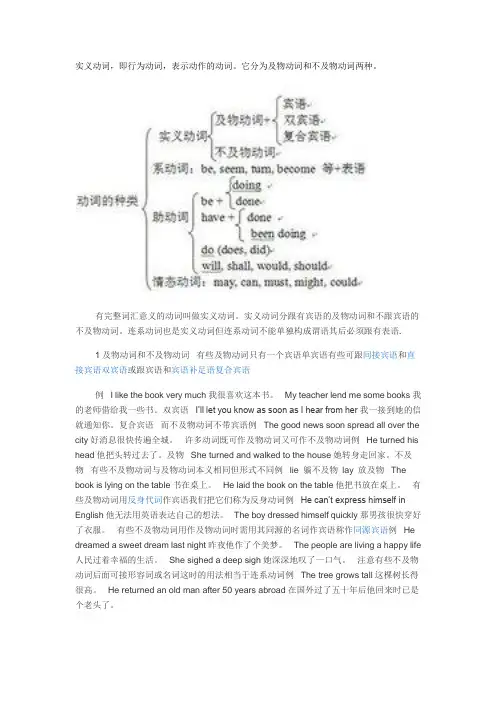
实义动词,即行为动词,表示动作的动词。
它分为及物动词和不及物动词两种。
有完整词汇意义的动词叫做实义动词。
实义动词分跟有宾语的及物动词和不跟宾语的不及物动词。
连系动词也是实义动词但连系动词不能单独构成谓语其后必须跟有表语.1及物动词和不及物动词有些及物动词只有一个宾语单宾语有些可跟间接宾语和直接宾语双宾语或跟宾语和宾语补足语复合宾语例 I like the book very much我很喜欢这本书。
My teacher lend me some books我的老师借给我一些书。
双宾语I’ll let you know as soon as I hear from her我一接到她的信就通知你。
复合宾语而不及物动词不带宾语例 The good news soon spread all over the city好消息很快传遍全城。
许多动词既可作及物动词又可作不及物动词例 He turned his head他把头转过去了。
及物 She turned and walked to the house她转身走回家。
不及物有些不及物动词与及物动词本义相同但形式不同例 lie 躺不及物lay 放及物 The book is lying on the table书在桌上。
He laid the book on the table他把书放在桌上。
有些及物动词用反身代词作宾语我们把它们称为反身动词例He can’t express himself in English他无法用英语表达自己的想法。
The boy dressed himself quickly那男孩很快穿好了衣服。
有些不及物动词用作及物动词时需用其同源的名词作宾语称作同源宾语例 He dreamed a sweet dream last night昨夜他作了个美梦。
The people are living a happy life 人民过着幸福的生活。
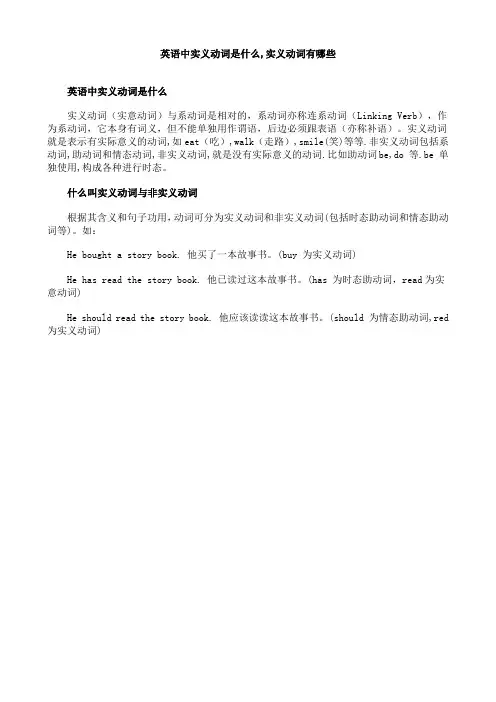
英语中实义动词是什么,实义动词有哪些
英语中实义动词是什么
实义动词(实意动词)与系动词是相对的,系动词亦称连系动词(Linking Verb),作为系动词,它本身有词义,但不能单独用作谓语,后边必须跟表语(亦称补语)。
实义动词就是表示有实际意义的动词,如eat(吃),walk(走路),smile(笑)等等.非实义动词包括系动词,助动词和情态动词,非实义动词,就是没有实际意义的动词.比如助动词be,do 等.be 单独使用,构成各种进行时态。
什么叫实义动词与非实义动词
根据其含义和句子功用,动词可分为实义动词和非实义动词(包括时态助动词和情态助动词等)。
如:
He bought a story book. 他买了一本故事书。
(buy 为实义动词)
He has read the story book. 他已读过这本故事书。
(has 为时态助动词,read为实意动词)
He should read the story book. 他应该读读这本故事书。
(should 为情态助动词,red 为实义动词)。
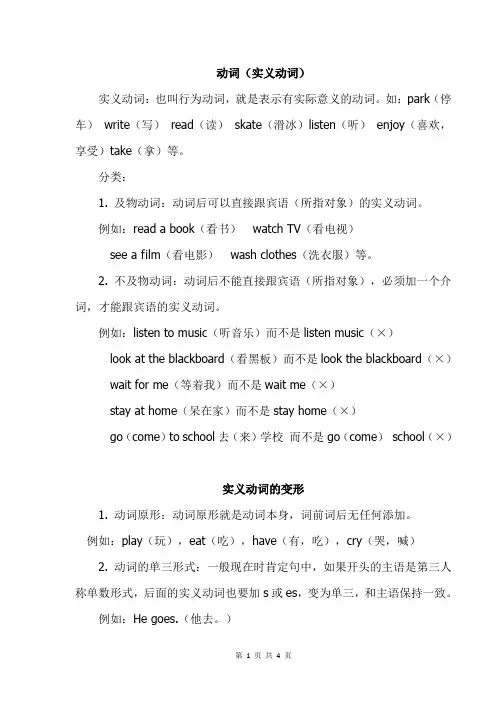
动词(实义动词)实义动词:也叫行为动词,就是表示有实际意义的动词。
如:park(停车)write(写)read(读)skate(滑冰)listen(听)enjoy(喜欢,享受)take(拿)等。
分类:1. 及物动词:动词后可以直接跟宾语(所指对象)的实义动词。
例如:read a book(看书)watch TV(看电视)see a film(看电影)wash clothes(洗衣服)等。
2. 不及物动词:动词后不能直接跟宾语(所指对象),必须加一个介词,才能跟宾语的实义动词。
例如:listen to music(听音乐)而不是listen music(×)look at the blackboard(看黑板)而不是look the blackboard(×)wait for me(等着我)而不是wait me(×)stay at home(呆在家)而不是stay home(×)go(come)to school去(来)学校而不是go(come)school(×)实义动词的变形1. 动词原形:动词原形就是动词本身,词前词后无任何添加。
例如:play(玩),eat(吃),have(有,吃),cry(哭,喊)2. 动词的单三形式:一般现在时肯定句中,如果开头的主语是第三人称单数形式,后面的实义动词也要加s或es,变为单三,和主语保持一致。
例如:He goes.(他去。
)She comes.(她来。
)Lingling plays.(玲玲玩。
)My aunt washes clothes.(我姨姨洗衣服。
)动词变为单三需要在词后面加es的情况:(1)以辅音字母加y结尾的动词,y变i加es,变为单三。
例如:fly(飞)——flies cry(哭,喊)——cries(2)以s、x、ch、sh结尾的动词,加es变为单三。
如:miss(想念)——misses fix(固定,修理)——fixes watch(观看)——watches wash(洗)——washesteach(教)——teaches(3)以o结尾的动词,加es,变为单三。
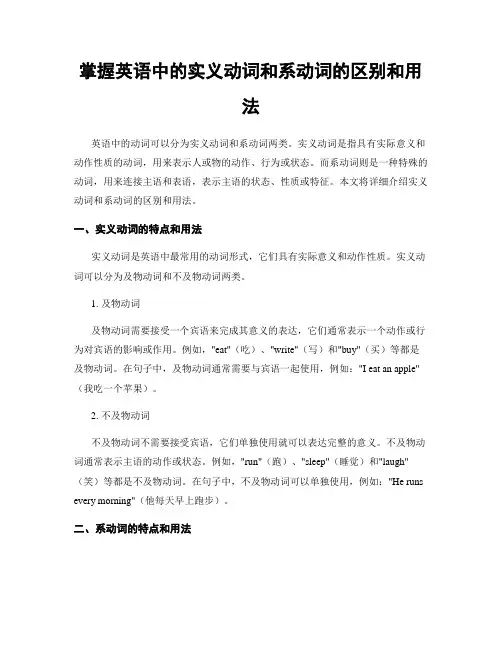
掌握英语中的实义动词和系动词的区别和用法英语中的动词可以分为实义动词和系动词两类。
实义动词是指具有实际意义和动作性质的动词,用来表示人或物的动作、行为或状态。
而系动词则是一种特殊的动词,用来连接主语和表语,表示主语的状态、性质或特征。
本文将详细介绍实义动词和系动词的区别和用法。
一、实义动词的特点和用法实义动词是英语中最常用的动词形式,它们具有实际意义和动作性质。
实义动词可以分为及物动词和不及物动词两类。
1. 及物动词及物动词需要接受一个宾语来完成其意义的表达,它们通常表示一个动作或行为对宾语的影响或作用。
例如,"eat"(吃)、"write"(写)和"buy"(买)等都是及物动词。
在句子中,及物动词通常需要与宾语一起使用,例如:"I eat an apple"(我吃一个苹果)。
2. 不及物动词不及物动词不需要接受宾语,它们单独使用就可以表达完整的意义。
不及物动词通常表示主语的动作或状态。
例如,"run"(跑)、"sleep"(睡觉)和"laugh"(笑)等都是不及物动词。
在句子中,不及物动词可以单独使用,例如:"He runs every morning"(他每天早上跑步)。
二、系动词的特点和用法系动词是一种特殊的动词,它用来连接主语和表语,表示主语的状态、性质或特征。
系动词通常没有实际意义,而是起到连接作用。
常见的系动词有"be"(是)、"seem"(似乎)和"feel"(感觉)等。
1. "be"系动词"be"系动词是最常用的系动词,它用来表示主语的身份、职业、性格、国籍等。
例如:"He is a teacher"(他是一名教师)和"She is American"(她是美国人)。
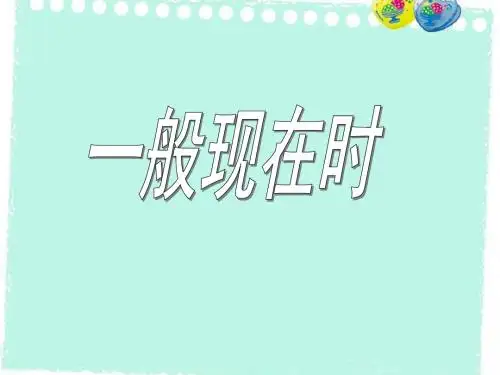
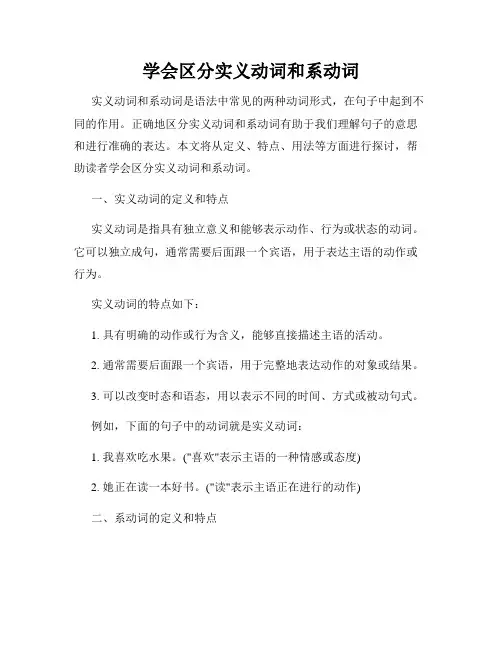
学会区分实义动词和系动词实义动词和系动词是语法中常见的两种动词形式,在句子中起到不同的作用。
正确地区分实义动词和系动词有助于我们理解句子的意思和进行准确的表达。
本文将从定义、特点、用法等方面进行探讨,帮助读者学会区分实义动词和系动词。
一、实义动词的定义和特点实义动词是指具有独立意义和能够表示动作、行为或状态的动词。
它可以独立成句,通常需要后面跟一个宾语,用于表达主语的动作或行为。
实义动词的特点如下:1. 具有明确的动作或行为含义,能够直接描述主语的活动。
2. 通常需要后面跟一个宾语,用于完整地表达动作的对象或结果。
3. 可以改变时态和语态,用以表示不同的时间、方式或被动句式。
例如,下面的句子中的动词就是实义动词:1. 我喜欢吃水果。
("喜欢"表示主语的一种情感或态度)2. 她正在读一本好书。
("读"表示主语正在进行的动作)二、系动词的定义和特点系动词是指不能表示动作或行为,只能用来连接主语和表语的动词。
它主要用于表达主语的状态、特征、身份等,起到“等于”、“变成”、“属于”等作用。
系动词的特点如下:1. 不能单独成句,必须和表语结合使用。
2. 不能改变时态和语态,只有一种形式。
3. 用于表示主语的状态或特征,充当等号的作用。
例如,下面的句子中的动词就是系动词:1. 他是一名医生。
("是"表示主语所属的身份或职业)2. 这些花变成了美丽的花束。
("变成"表示主语的状态发生了改变)三、实义动词和系动词的用法区别实义动词和系动词在句子中的用法有一些区别:1. 实义动词通常后面跟一个宾语,形成完整的动宾结构,而系动词通常后面是表语,用于进一步描述主语。
2. 实义动词表示具体的动作或行为,强调动作的进行,而系动词则表示主语的状态或特征,强调状态的持续。
3. 实义动词可以改变时态和语态,而系动词只有一种形式。
4. 实义动词可以使用被动形式,而系动词不能。
动词种类1——实义动词一.语法梳理:实义动词也叫行为动词,是在句子中能够独立作谓语的动词。
根据其后是否可以直接跟宾语,可分为:及物动词和不及物动词。
1.及物动词(vt)及物动词后面能直接跟宾语常用的基本句型:主+谓+宾(He reached Paris three days ago.)主+谓+直接宾语+间接宾语(He bought a gift for me./He bought me a gift.)主+谓+宾+宾补(名词、形容词、副词、不定式、分词等)E.g. The couple named their baby Henry.He found the trip exciting.The boy knocked the tea pot over.They asked me to go fishing with them.I saw John punished.【温馨提示】·1. 有些动词后可跟省略to的不定式或现在分词做宾语补足语,需要特殊记忆,感官动词(see, feel, hear, watch, notice等)和使役动词(have, make, let等)e.g. I often see them ________ basketball on the playground. (play)I heard him ___________ in the classroom when I passed by. (sing)2.常见的后面跟双宾语的动词有:pass, offer, give, send, lend等。
若间接宾语(sb.)置于直接宾语(sth.)后面时,间接宾语前要加to(表方向)或for(表目的)e.g. Please pass me the salt. =Please pass the salt _________ me.My parents bought me a nice backpack. =My parents bought a nice backpack ______ me.2.不及物动词(vi.)不及物动词一般情况下后面不能直接跟宾语,需要和介词或副词搭配使用后才能跟宾语。
实义动词实义动词(实意动词)与系动词是相对的,系动词亦称连系动词(Linking Verb),作为系动词,它本身有词义,但不能单独用作谓语,后边必须跟表语(亦称补语),构成系表结构说明主语的状况、性质、特征等情况。
实义动词意思完全,能独立用作谓语。
实义动词有及物动词和不及物动词(及物动词是指后面要求有直接宾语的动词;不及物动词指后面不需要跟宾语的动词)即行为动词,表示动作的动词。
它分为及物动词和不及物动词两种中文名实义动词外文名Notional Verb;lexical verb; full verb 别名实意动词目录1 简介▪实义动词▪及物动词▪不及物动词2 用法简介编辑实义动词实义动词:及物动词(带宾语);不及物动词(不带宾语)。
实实在在有意思的动词。
及物动词后面必须跟宾语,意义才完整的实义动词,叫做及物动词(transitive verb)。
英语中的及物动词有:interest,worry,guess,please,surprise,love等例如:I believe that the committee will consider our suggestion.我相信委员会将会考虑我们的建议。
“How long can I keep the book ”Harry asked.哈里问:“这本书我可以借多久”Dr. Bethune set us a good example. 白求恩大夫给我们树立了好榜样。
Crude oil contains many useful substances.原油含有许多有用的物质。
不及物动词本身意义完整,后面不用跟宾语的实义动词,叫做不及物动词(intransitive verb)。
Birds can fly.鸟会飞。
It happened in June 1932.这件事发生于一九三二年六月。
My watch stopped.我的表停了。
She spoke at the meeting yesterday evening. 她在昨天晚上的会上发了言。
实义动词和情态动词,分别是什么?有何区别?实义动词和情态动词是根据动词的句法功能分类的。
情态动词又叫情态助动词。
一、实义动词也叫主动词,有具体的词汇意义,表示主语发出的动作或所处的状态。
在陈述句中,实义动词可以单独作谓语。
实义动词加表语(主补)、宾语或状语构成谓语部分。
She is an English teacher and she works hard. (单词动词作谓语)He enjoys swimming and gave us a performance last Sunday. (单词动词作谓语)Mr Smith has been teaching in a middle school for 30 years. (加助动词作谓语)二、助动词不能单独做谓语,后面要加主动词,用来帮助主动词的某种形式构成疑问句、否定句、进行时态、完成时态、被动语态和虚拟语气等语法变体。
助动词分为基本助动词和情态助动词两类。
(一)基本助动词没有词汇意义(be: is, am, are; was, were; have / has / had been; being, having been; do: do, does, did; have: have, has, had...)。
(二)情态助动词具有不同的情态意义。
(will会,将, would会,将; shall将, should应该; can可能,也许, could可能; may也许, might可能; muts必须,一定, have / had to不得不; used to过去常常, need需要, dare敢, ought to应该;...)如:Did he give you a performance last Sunday? (加did构成疑问句)No, he didn't give us a performance last Sunday. (加didn't 构成否定句)I haven't received his letter for a whole month. (加haven't构成完成时态)Something must be done to make the rivers clean.(加must be构成含情态意义的被动语态)If everyone bought one soft-drink can each day and threw it away, there would soon be a huge mountain of rubbish. (加would 构成虚拟语气)。
七年级英语主要实义动词及用法实义动词是用来表示行为或状态的动词,它们是句子的中心和核心。
在七年级的英语学习中,掌握一些最常用的实义动词及其用法是非常重要的。
下面是七年级英语主要实义动词及其用法。
1. Be (是,存在,有)- Be是英语中最常用的动词之一,它用来表示存在、状态和性质。
Be有三种时态形式:am, is, are。
例如:- I am a student.(我是一名学生)- He is tall.(他很高)- They are my friends.(他们是我的朋友)2. Have (有,拥有)- Have用来表示拥有或持有某物。
Have有三种时态形式:have, has, had。
例如:- I have a new book.(我有一本新书)- She has a pet dog.(她有一只宠物狗)- We had a great time.(我们度过了愉快的时光)3. Do (做)- Do是用来表示进行某种活动或行为的动词。
Do有三种时态形式:do, does, did。
例如:- I do my homework every day.(我每天做作业)- She does her chores after school.(她放学后做家务)- We did our best in the competition.(我们在比赛中尽了最大的努力)4. Make (制造,做)- Make常用来表示制造或做某物。
例如:- I make a cake for my friend's birthday.(我为朋友的生日做了一个蛋糕)- She makes a beautiful painting.(她画了一幅美丽的画)- We made a plan for the trip.(我们为旅行制定了计划)5. Say (说)- Say是用来表示说话或陈述的动词。
例如:- He said he would come to the party.(他说他会来参加派对)- She says she likes to read.(她说她喜欢阅读)- We said goodbye to our friends.(我们和朋友们说再见)6. Go (去)- Go表示动作的方向是离开此地向另一个地方移动。
实义动词实义动词(实意动词)与系动词是相对的,系动词亦称连系动词(Linking Verb),作为系动词,它本身有词义,但不能单独用作谓语,后边必须跟表语(亦称补语),构成系表结构说明主语的状况、性质、特征等情况。
实义动词意思完全,能独立用作谓语。
实义动词有及物动词和不及物动词(及物动词是指后面要求有直接宾语的动词;不及物动词指后面不需要跟宾语的动词)即行为动词,表示动作的动词。
它分为及物动词和不及物动词两种中文名实义动词外文名Notional Verb;lexical verb; full verb 别名实意动词目录1 简介▪实义动词▪及物动词▪不及物动词2 用法简介编辑实义动词实义动词:及物动词(带宾语);不及物动词(不带宾语)。
实实在在有意思的动词。
及物动词后面必须跟宾语,意义才完整的实义动词,叫做及物动词(transitive verb)。
英语中的及物动词有:interest,worry,guess,please,surprise,love等例如:I believe that the committee will consider our suggestion.我相信委员会将会考虑我们的建议。
“How long can I keep the book ”Harry asked.哈里问:“这本书我可以借多久?”Dr. Bethune set us a good example. 白求恩大夫给我们树立了好榜样。
Crude oil contains many useful substances.原油含有许多有用的物质。
不及物动词本身意义完整,后面不用跟宾语的实义动词,叫做不及物动词(intransitive verb)。
Birds can fly.鸟会飞。
It happened in June 1932.这件事发生于一九三二年六月。
My watch stopped.我的表停了。
She spoke at the meeting yesterday evening. 她在昨天晚上的会上发了言。
3)兼作及物动词和不及物动词英语里有不少实义动词可以兼作及物动词和不及物动词。
这样的动词又有两种不同的情况:a)兼作及物动词和不及物动词时,意义不变。
试比较:Shall I begin at once?我可以立刻开始吗?(begin作不及物动词)She began working as a librarian after she left school.她毕业后当图书馆管理员。
(began作及物动词)When did they leave Chicago?他们是什么时候离开芝加哥的?(leave 作及物动词)They left last week. 他们是上周离开的。
(left 作不及物动词)b)兼作及物动词和不及物动词时,有时意义不尽相同。
如:Wash your hands before meals.饭前要洗手。
Does this cloth wash well? 这布经得起洗吗?4)与汉语的比较有时英语动词的及物和不及物的用法,与汉语的用法完全不一样,请注意下列两种情况:a)有的动词在英语里只能用作不及物动词,而汉语则可用作及物动词,如arrive到达,agree同意,listen听。
英语里这些动词后面常接介词。
如:We arrived at the railway station at noon.我们于中午到达火车站。
(at不能省去)(比较:We reached the railway station at noon.)Everybody listened to the lecture with great interest.每个人都很有兴趣地听讲课。
(to不可省去)(比较:We all heard the lecture.)Do they agree to the plan?他们同意这个计划吗?(to不可以省去)b)有的动词在英语里能用作及物动词,而在汉语里则不能用作及物动词,如serve为…服务。
Our children are taught to serve the people wholeheartedly.我们的儿童被教以全心全意为人民服务用法编辑实义动词词义完整,能独立作谓语,可分成:及物动词(transitive verb)和不及物动词(intransitive verb)。
1.及物动词要求有宾语①Mr.Smith gave his wife twenty pounds for her birthday.史密斯先生给了他的妻子20英镑过生日。
②He asked the teacher a few questions.他向老师问了几个问题。
③We have friends all over the world.我们的朋友遍天下。
④Children and young people like bright colors.孩子和年轻人喜欢亮丽的颜色。
2.不及物动词不要求有宾语①Most shops in Britain open at 9:00 A.m. and close at 5:00 or 5:30 in the evening .英国大部分商店九点开门,晚五点或五点半关门。
②George's father lives there.乔治的爸爸住在那里。
③Let's go home.我们回家吧。
④The examination ended at 11:30 A.m.考试上午十一点半结束。
3.特殊实义动词英语动词很多既是及物动词又是不及物动词,如close,begin,study,leave,work等。
①The post office closes at 9:00 p. m.邮局晚上9点关门。
②Close the window,please.请关窗。
③Shall we begin now?我们现在开始吗?④Bill began working as a sailor after he left school.比尔毕业后当水手。
⑤They left yesterday.他们昨天离开的。
⑥When did you leave Washington?你什么时候离开华盛顿的?⑦The students study hard.这些学生学习努力。
⑧The students study English and German.这些学生学习英语和德语。
⑨He works in a supermarket.他在一家超市工作。
⑩He works the machine on Mondays.他星期一操作这台机器。
3。
实义动词,也叫行为动词。
就我们现在所学的内容来讲,实义动词所在的句子中一般不存在be动词。
也就是在含有实义动词的句子变否定句或疑问句时,一定不能用be动词。
那么,实义动词究竟怎样用呢?正如be动词随着主语的变化可变为am、is、are一样,实义动词在肯定句中,也要随着主语的变化而变化。
当主语为第三人称单数he,she,it时,实义动词要变为相应的第三人称单数;当主语为非第三人称单数I,you(你),we,you(你们)they 时,实义动词要用动词的原形。
而在变否定句和疑问句时,不能直接在动词上变,而是要借助另一类动词:助动词do、does。
⑴肯定句:①I have a blue book.②He has a brother.③She wants to be a teacher.④They like to play basketball.⑵否定句:主语+don’t/doesn’t+动词原形。
其中do/does为助动词,是来帮助实义动词构成否定或疑问句的,但加了do/does后,其后面的动词必须用动词原形。
①I have a blue book.(变为否定句)→I don’t have a blue book.②He has a brother. (变为否定句)→He doesn’t have brother.③She wants to be a teacher. (变为否定句)→She doesn’t want to be a teacher.④They like to play basketball. (变为否定句)→They don’t like to play basketball.⑶一般疑问句:Do/Does +主语+动词原形+其他?句中加了do/does后,其后面的动词还是必须用动词原形。
①I have a blue book.(变为一般疑问句)→Do you have a blue book?②He has a brother. (变为一般疑问句)→Does he have a brother?③My brother does his homework before supper. (变为一般疑问句)→Does your brother do his homework before supper?④She wants to be a teacher. (变为一般疑问句)→Does she want to be a teacher?⑤They like to play basketball. (变为一般疑问句)→Do they like to play basketball?⑷特殊疑问句:特殊疑问词+一般疑问句?①Your sister likes English best because it’s interesting.(对加粗部分提问)→Why does your sister like English best?②He does his homework before supper. (对加粗部分提问)→When does he do his homework?注意:当含有and引导的短语在句中做谓语或宾语,我们把这类句子变否定句时,必须把and变为or.如:⑴He can swim and dance. (变为否定句)→He can’t swim or dance.⑵My father likes English and math. (变为否定句)→My father doesn’t like English or math.⑸but和except后。
but前是实义动词do时,后面出现的不定式不带to。
例如:He wants to do nothing but go out. 他只想出去玩。
比较:He wants to believe anything but to take the medicine. 除了吃这药,他什么都信。